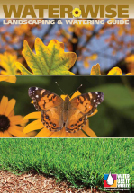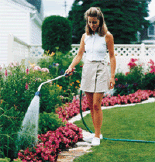|
|
Watering Your GardenOne thing most avid gardeners understand is the importance of getting water to their plants on a consistent basis. They watch how their plants are doing and let the plants tell them what they need. They water only when necessary and deep enough to saturate the whole root system. Watering is essential to a healthy garden and doing it properly will keep your garden looking fresh throughout the year. 1. Identify the plant material you have in your garden. Azaleas, Junipers and yews, very common in many gardens, once established require very little water. Junipers and Yews are two plants that decline the most from over watering. Mature (older) plant material that has been in your garden for a long time will require very little supplemental watering. Once again, watch your plants, they will tell you what they need. Save your water and your time. 2. Plants that are in the shade for most of the day will require watering less often. Be careful, you can over water very easily. Check the soil before you water, if wet leave alone. 3. Water directly onto your plant material with a hose. Using a spray head with a wand is more efficient and directs the water exactly where it needs to be. DO NOT USE A SPRINKLER. A sprinkler is very inefficient with where the water goes and you end up watering more of your garden than you need. The more water you put on open sunny areas of your garden, the better chance that you will be pulling lots of weeds. Water selected plant root systems only. 4. When watering newly installed plant material, THIS IS CRUCIAL. Average size of root balls, in the ground, on new plant material is anywhere from 4”-8” deep. When you water these plants, make sure the flow of water coming out of the hose is slow. What you want is the water to slowly flow onto the root ball for about 5 seconds and then you move the hose on to the next plant. You want the water to soak down into the root ball, not run off to the sides. Stopping after 5 seconds and moving to the next plant allows the water to penetrate the soil and soak into the ground. After watering the next plant for five seconds, go back to the first plant and do the same thing over again. Continue moving back and forth to all of your plants this way until you feel like you have enough water, By following this method, you can be assured that the root balls of your plants are getting enough water and when the roots are saturated, your plants remain healthy, mature you water less often. 5. Don’t ever count on the rain to water anything in your garden. Unless it rains slow and steady for the entire day, most rain water probably doesn’t penetrate into the ground more than 1”. Remember how we talked about the root balls being 4”-8” deep, in an average rain, most of the roots would dry out and die. Don’t count on the rain. 6. Be very careful when watering your plant material with an in ground irrigation system. Once again, if you have a mature landscape, you probably need very little supplemental water. You could be wasting a lot of water that your plants don’t need. If your system has been in the garden for a while and you have pop up spray heads, turn your system on and check that the heads are not being blocked by plants that have grown over the spray area. This happens a lot and is something that your irrigation tech should recognize. The biggest concern with this type of system is that it is run too often, the soil never has an opportunity to dry out and a lot of the plantings slowly decline from too much water and lack of oxygen in the soil. Great idea, use with caution. Proper watering of your garden will take a little of your time and a lot of good sense. Pay attention to your plants and what they are telling you. They speak volumes. Establishment of new plant material, depending on time of year, will require water 2-3 times a week for a month or two. Then monitor. Know your soil and watch your temperatures. Plants will show symptoms of drought (drooping leaves, decreased vigor) also when they are getting too much water. Sunny, higher temperatures may require more water. Cooler, cloudy less water. Most important, let your soil dry out a little between waterings. Most plants can't breath under water. Todd Wessel For more information on watering your garden, please read this article on hand watering your garden. |
|
|||||||||||
|
|||||||||||||
|
|
|||||||||||||




